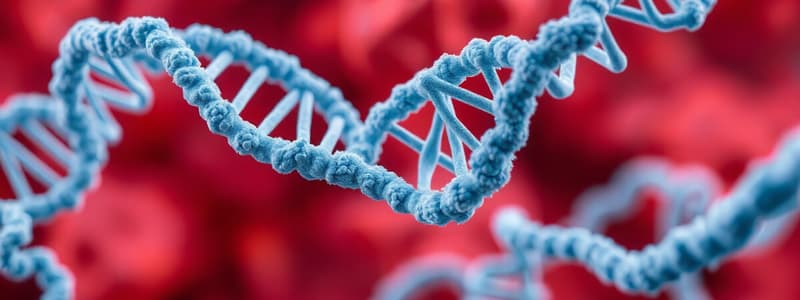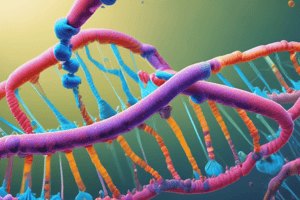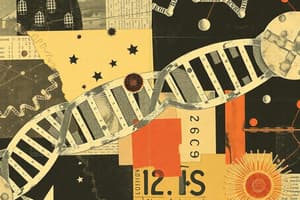Podcast
Questions and Answers
Which bond ensures the primary structure of proteins:
Which bond ensures the primary structure of proteins:
- Glycosidic bond
- Hydrophobic bond
- Hydrogen bond
- Polypeptide bond (correct)
- Phosphodiester bond
Which bond ensures the secondary structure of protein:
Which bond ensures the secondary structure of protein:
- Hydrophobic bond
- Glycosidic bond
- Polypeptide bond
- Hydrogen bond (correct)
- Phosphodiester bond
Which bonds participate in formation of the quaternary structure of proteins:
Which bonds participate in formation of the quaternary structure of proteins:
- All mentioned above (correct)
- Hydrophobic bond
- Hydrogen bond
- Van der Waals attraction
- Ionic bond
What is the name of the primary structure of protein?
What is the name of the primary structure of protein?
What is the name of the secondary structure of protein?
What is the name of the secondary structure of protein?
What is an example of quaternary structure of proteins?
What is an example of quaternary structure of proteins?
What kind of bond is responsible for primary structure of DNA?
What kind of bond is responsible for primary structure of DNA?
Which bonds are responsible for secondary structure of DNA?
Which bonds are responsible for secondary structure of DNA?
Flashcards
Primary Structure of Proteins
Primary Structure of Proteins
The linear sequence of amino acids in a protein chain, determined by the polypeptide bonds between them.
Secondary Structure of Proteins
Secondary Structure of Proteins
The local folding patterns of the polypeptide chain, formed by hydrogen bonding between amino acids. Common structures include alpha helixes and beta sheets.
Quaternary Structure of Proteins
Quaternary Structure of Proteins
The arrangement of multiple polypeptide chains (subunits) in a protein complex, stabilized by various noncovalent interactions like hydrogen bonds, ionic bonds, hydrophobic interactions, and van der Waals forces.
Polypeptide Chain
Polypeptide Chain
Signup and view all the flashcards
Alpha Helix & Beta Sheets
Alpha Helix & Beta Sheets
Signup and view all the flashcards
Hemoglobin
Hemoglobin
Signup and view all the flashcards
Primary Structure of DNA
Primary Structure of DNA
Signup and view all the flashcards
Secondary Structure of DNA
Secondary Structure of DNA
Signup and view all the flashcards
Polynucleotide Chain
Polynucleotide Chain
Signup and view all the flashcards
DNA Double Helix
DNA Double Helix
Signup and view all the flashcards
Chromosome
Chromosome
Signup and view all the flashcards
Ribosome
Ribosome
Signup and view all the flashcards
DNA Packaging Levels
DNA Packaging Levels
Signup and view all the flashcards
Nucleosome
Nucleosome
Signup and view all the flashcards
Solenoid
Solenoid
Signup and view all the flashcards
MAR (Matrix Attachment Region)
MAR (Matrix Attachment Region)
Signup and view all the flashcards
Thymine
Thymine
Signup and view all the flashcards
Guanine & Cytosine
Guanine & Cytosine
Signup and view all the flashcards
Uracil
Uracil
Signup and view all the flashcards
Phosphodiester Bond
Phosphodiester Bond
Signup and view all the flashcards
Hydrogen Bond
Hydrogen Bond
Signup and view all the flashcards
rER (Rough Endoplasmic Reticulum)
rER (Rough Endoplasmic Reticulum)
Signup and view all the flashcards
sER (Smooth Endoplasmic Reticulum)
sER (Smooth Endoplasmic Reticulum)
Signup and view all the flashcards
GA (Golgi Apparatus)
GA (Golgi Apparatus)
Signup and view all the flashcards
Lysosome
Lysosome
Signup and view all the flashcards
Acid Lipase
Acid Lipase
Signup and view all the flashcards
Insulin Receptor
Insulin Receptor
Signup and view all the flashcards
Tubulin
Tubulin
Signup and view all the flashcards
Mitochondria
Mitochondria
Signup and view all the flashcards
Cardiolipin
Cardiolipin
Signup and view all the flashcards
Active Transport
Active Transport
Signup and view all the flashcards
Simple Diffusion
Simple Diffusion
Signup and view all the flashcards
Na-K Pump
Na-K Pump
Signup and view all the flashcards
Study Notes
Protein Structure
- Primary Structure: Polypeptide chain of amino acids linked by peptide bonds.
- Secondary Structure: Alpha helix or Beta sheets, stabilized by hydrogen bonds between amino acid backbones.
- Tertiary Structure: Complex 3D folding of the polypeptide chain, stabilized by various interactions (hydrogen bonds, hydrophobic interactions, disulfide bridges, ionic bonds).
- Quaternary Structure: Interaction of multiple polypeptide chains to form a functional protein complex, held together by various bonds (hydrogen bonds, ionic bonds, hydrophobic interactions).
DNA Structure
- Primary Structure: Polynucleotide chain composed of nucleotides linked by phosphodiester bonds.
- Secondary Structure: Double helix formed by two polynucleotide strands held together by hydrogen bonds between complementary base pairs (adenine with thymine, guanine with cytosine).
Cellular Processes
- Ribosome Function: Synthesizing proteins, either free or bound in the endoplasmic reticulum.
- Golgi Apparatus (GA) Function: Modifying, sorting, and packaging proteins.
- Endoplasmic Reticulum (ER) Function: Modifying and transporting proteins made by ribosomes.
- Lipid Synthesis: Endoplasmic reticulum, for lipids and proteins
- Cellular Transport: Facilitated diffusion, active transport as mechanism across cell membranes.
- Detoxification: Endoplasmic Reticulum for detoxification.
- Nucleosome Level: DNA is packed around histone proteins.
- Solenoid Level: Nucleosomes are organized into a tightly wound solenoid structure.
- Third Level (Loop): DNA interacts with scaffolding proteins.
Molecular Biology Test - Specific Questions
- DNA monomer: dNTP
- Acidic pH (pH=5): Lysosome
Studying That Suits You
Use AI to generate personalized quizzes and flashcards to suit your learning preferences.




